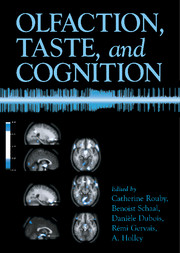Book contents
- Frontmatter
- Contents
- Contributors
- Preface
- Acknowledgments
- A Tribute to Edmond Roudnitska
- OLFACTION, TASTE, AND COGNITION
- Section 1 A Specific Type of Cognition
- Section 2 Knowledge and Languages
- Section 3 Emotion
- Section 4 Memory
- Section 5 Neural Bases
- 18 Odor Coding at the Periphery of the Olfactory System
- 19 Human Brain Activity during the First Second after Odor Presentation
- 20 Processing of Olfactory Affective Information: Contribution of Functional Imaging Studies
- 21 Experience-induced Changes Reveal Functional Dissociation within Olfactory Pathways
- 22 Increased Taste Sensitivity by Familiarization to Novel Stimuli: Psychophysics, fMRI, and Electrophysiological Techniques Suggest Modulations at Peripheral and Central Levels
- 23 The Cortical Representation of Taste and Smell
- Section 6 Individual Variations
- Index
- References
20 - Processing of Olfactory Affective Information: Contribution of Functional Imaging Studies
Published online by Cambridge University Press: 21 September 2009
- Frontmatter
- Contents
- Contributors
- Preface
- Acknowledgments
- A Tribute to Edmond Roudnitska
- OLFACTION, TASTE, AND COGNITION
- Section 1 A Specific Type of Cognition
- Section 2 Knowledge and Languages
- Section 3 Emotion
- Section 4 Memory
- Section 5 Neural Bases
- 18 Odor Coding at the Periphery of the Olfactory System
- 19 Human Brain Activity during the First Second after Odor Presentation
- 20 Processing of Olfactory Affective Information: Contribution of Functional Imaging Studies
- 21 Experience-induced Changes Reveal Functional Dissociation within Olfactory Pathways
- 22 Increased Taste Sensitivity by Familiarization to Novel Stimuli: Psychophysics, fMRI, and Electrophysiological Techniques Suggest Modulations at Peripheral and Central Levels
- 23 The Cortical Representation of Taste and Smell
- Section 6 Individual Variations
- Index
- References
Summary
A central concern in contemporary cognitive neuroscience is how stimulus information is represented in the human central nervous system. One approach to this issue is to examine the neural correlates of different types of stimuli in different modalities to determine the functional organization of distinct cortical and/or subcortical pathways associated with particular types of stimulus features. This approach has proved particularly powerful for understanding how visual processes are organized, for example. Much less is currently known about how the brain encodes olfactory sensory information. Despite progress in understanding the basic mechanisms of coding at the receptor level (Duchamp-Viret, Chaput, and Duchamp, 1999), cortical processing of odor quality remains largely unknown, especially in the human brain. One property of the chemical senses that differentiates them from other modalities is their strong hedonic association. Unlike visual and auditory stimuli, odors and tastes often result in strong affective reactions. That aspect of odor processing raises interesting questions about the neural substrates that account for the salient hedonic value of odors.
In the past decade, cognitive neuroscientists have benefited enormously from the development of functional neuroimaging, which allows noninvasive exploration of the brain. Those techniques measure changes in hemodynamic responses as functions of stimulus or task demands, thus permitting assessments of the neural activities associated with a wide variety of cognitive and perceptual processes. Neuroimaging complements more conventional approaches such as neurophysiological studies and lesioning studies of behavior, which continue to be of considerable importance in understanding brain–behavior relationships.
Information
- Type
- Chapter
- Information
- Olfaction, Taste, and Cognition , pp. 324 - 334Publisher: Cambridge University PressPrint publication year: 2002
References
Accessibility standard: Unknown
- 3
- Cited by
